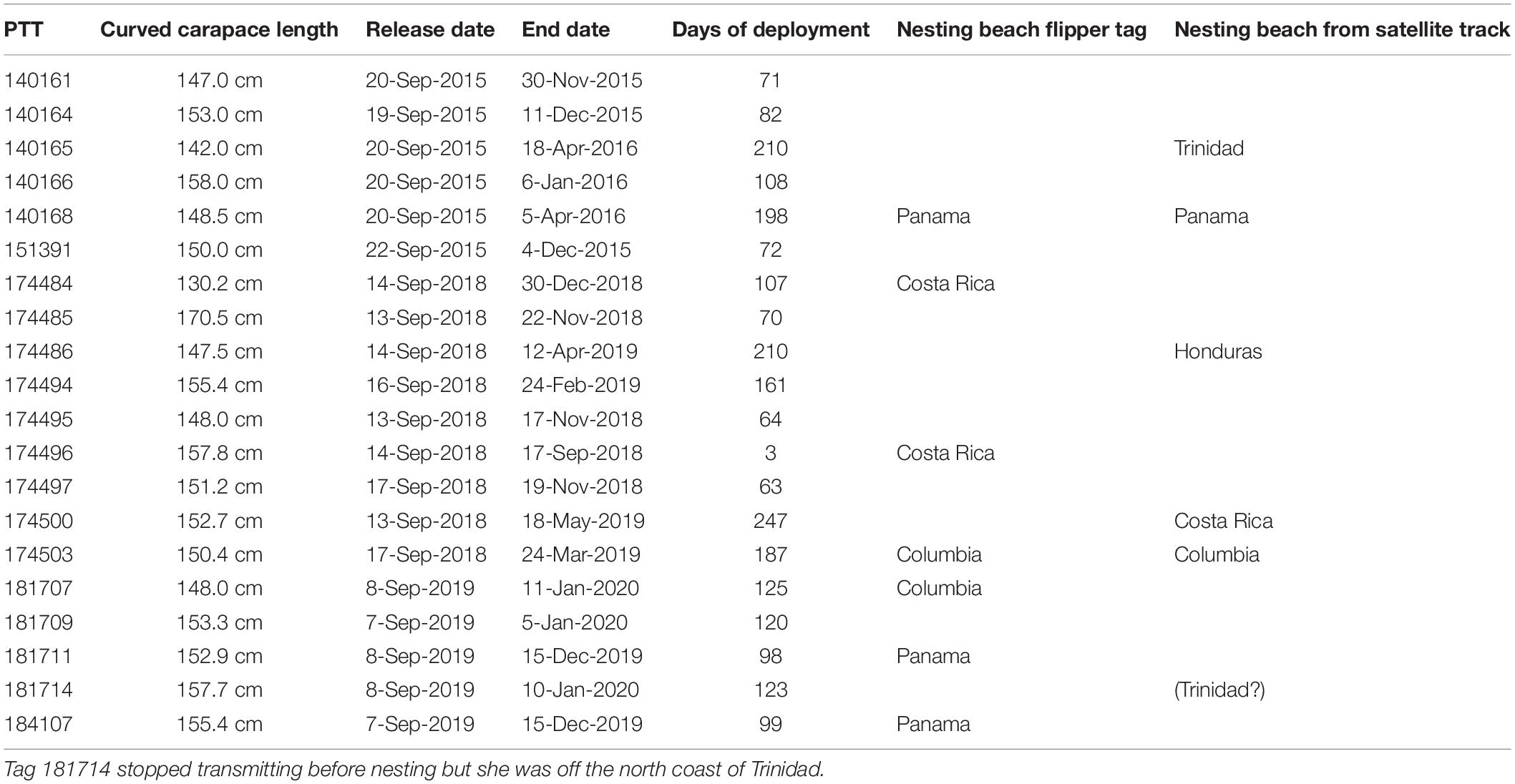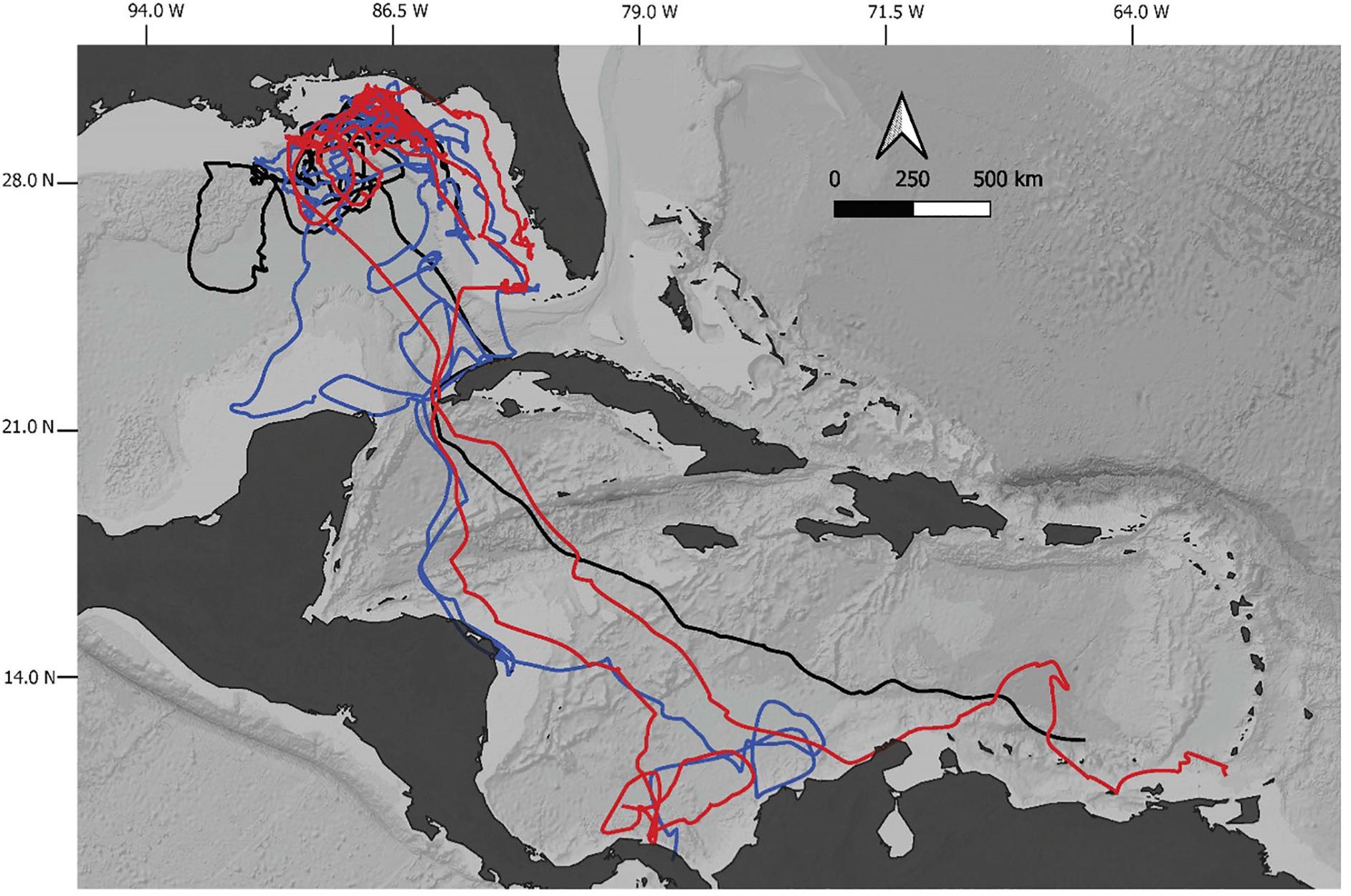- 1NOAA Fisheries, Southeast Fisheries Science Center, Miami, FL, United States
- 2Marine Mammal and Turtle Division, Southwest Fisheries Science Center, National Marine Fisheries Service, National Oceanic and Atmospheric Administration, Moss Landing, CA, United States
- 3Moss Landing Marine Laboratories, San Jose State University, Moss Landing, CA, United States
- 4LGL Ecological Research Associates, Bryan, TX, United States
- 5NOAA Fisheries, Office of Protected Resources, Gainesville, FL, United States
We deployed 19 satellite tags on foraging adult leatherback turtles, including 17 females and 2 males, captured in the northeastern Gulf of Mexico in 2015, 2018, and 2019 in order to study regional distribution and movements. Prior to our study, limited data were available from leatherbacks foraging in the Gulf of Mexico. Tag deployment durations ranged from 63 to 247 days and turtles exhibited three distinct behavior types: foraging, transiting, or rapidly switching between foraging and transiting. Some females were tracked to nesting beaches in the Caribbean. Most of the leatherbacks remained on and foraged along the west Florida continental shelf whereas a few individuals foraged in waters of the central Gulf of Mexico during the autumn and winter. In addition, migration of adult females through the Yucatan Channel indicate that this is a seasonally important area for Caribbean nesting assemblages.
Introduction
Movement characterizes the life cycles of marine animals (Putman, 2018) and understanding the role of individual movements on species distributions and habitat use is an important component of scientifically sound management efforts (Blumenthal et al., 2006; Oppel et al., 2018). Satellite-telemetry methods have been widely used in large-bodied marine animals to determine their movements and habitat associations, and have yielded considerable insights into sea turtle biology and behavior (Hays et al., 2019). Sea turtles are particularly well-suited for satellite telemetry because tags can be affixed to their carapaces, and their obligate air-breathing and other surface behaviors allow data to be reliably transmitted to satellites. The majority of satellite tags are deployed on nesting female sea turtles because of easy access by researchers (James et al., 2005). While this approach provides useful information, the data are biased toward females and inter-nesting and post-nesting periods.
Leatherback turtles (Dermochelys coriacea) inhabiting the Northwest Atlantic are one of seven populations that comprise the global distribution of this endangered species (National Marine Fisheries Service, and U.S. Fish and Wildlife Service, 2020). Multiple researchers have deployed satellite tags on female leatherbacks in nesting locations in the United States (Florida), Central America, the Caribbean, and South America (e.g., Hays et al., 2004; Eckert, 2006; Eckert et al., 2006; Fossette et al., 2007). Fewer in-water studies of this population have been conducted and mostly tagged turtles off the Atlantic coast of North America, documenting foraging areas that extend into high-latitudes (e.g., in waters near Canada and the United Kingdom; James et al., 2007; Dodge et al., 2014). Thus, the movement behavior of leatherbacks in the Atlantic, and movements to tropical nesting sites are relatively well known (James et al., 2005; Mills Flemming et al., 2010).
However, Northwest Atlantic leatherbacks also forage in the western Equatorial Atlantic and Gulf of Mexico, but there has been little directed research in these areas. The Gulf of Mexico may be a particularly important area for leatherbacks based on a recent study by Aleksa et al. (2018b) that identified foraging hotspots using telemetry data from Caribbean nesting turtles (n = 10) and turtles sampled off the Florida Panhandle (n = 6). The northeastern Gulf of Mexico off the Florida Panhandle and the southeastern Gulf of Mexico in the Bay of Campeche off the state of Tabasco, Mexico were identified as primary foraging areas. These two areas exhibit high primary productivity partly due to nearby high discharge-rate rivers (the Mississippi River and Rio Grijalva; David and Kjerfve, 1998).
Leatherbacks are present in the Gulf of Mexico year-round as demonstrated by Aleksa et al. (2018b), and recorded bycatch in pelagic longline fisheries (Garrison and Stokes, 2017). Leatherback abundance in the Gulf of Mexico is greater during summer and early autumn months as post-nesting turtles enter the Gulf from Caribbean nesting beaches during the summer, and depart to the Caribbean in the late autumn (Aleksa et al., 2018b and here). This seasonality coincides with the increased abundance of preferred gelatinous zooplankton prey (e.g., jellyfish, Aleksa et al., 2018a).
Salinity, temperature, nutrients, distance from shore, and water movements are factors that affect the abundance of jellyfish in the Gulf of Mexico (Aleksa et al., 2018a). These factors, along with physical oceanic features, such as convergence zones and eddies, provide conditions that concentrate leatherback prey. Leatherbacks are noted to forage along physical oceanic features where jellyfish are aggregated in the open ocean (Benson et al., 2011), and selectively feed on preferred jellyfish prey at foraging areas (Benson et al., 2007; Heaslip et al., 2012; Dodge et al., 2014). In the northern Gulf of Mexico, leatherbacks have been observed selectively feeding on pink meanie jellyfish (Drymonema larsoni, Aleksa et al., 2016). The pink meanie is a large scyphomedusa that is a predator on other jellyfish such as Aurelia spp.
Leatherbacks that forage in the northeast Gulf of Mexico appear to follow similar paths when leaving the Gulf in the autumn. Previously tagged turtles that departed the foraging area to return to the Caribbean mostly migrated southward on the west Florida shelf and used a secondary foraging area off southwestern Florida (Aleksa et al., 2018b).
A greater understanding of foraging and migration behavior by leatherbacks in the eastern Gulf of Mexico first described in Aleksa et al. (2018b) requires a larger sample size of satellite tagged leatherbacks that use the northern Gulf of Mexico foraging area. To elucidate the behavioral state of individuals during their movements, we used oceanographic features in combination with satellite telemetry data from nineteen leatherbacks tagged in the northern Gulf of Mexico. Data were assessed in a hierarchical Bayesian state space model with joint estimation over all individuals to infer behavioral states of leatherbacks, identifying whether portions of the track were associated with migration, foraging, or nesting behavior (Jonsen, 2016).
Materials and Methods
Leatherback turtles were located by a spotter aircraft that directed the capture vessel to the turtles. Turtles were captured with a 2-m breakaway hoop net attached to the vessel and, upon successful capture, the turtle was lifted out of the water in a basket (2015) or brought aboard a small inflatable craft for examination and attachment of a telemetry tag (2018 and 2019). The general health of each captured turtle was evaluated based on visual examination and metal flipper tags and passive integrated transponder tags were documented or applied, if not already present. Curved carapace length and width measurements were obtained, and sex identification was determined based on tail length. A satellite-linked transmitter with FASTLOC GPS capacity (Wildlife Computers MK-10AF) was attached via a tether attached to the caudal peduncle prior to release (NMFS SEFSC –National Marine Fisheries Service Southeast Fisheries Science Center, 2008). Only robust, active turtles without any evident major injuries were tagged. The entire process from capture to release required approximately 30 min. GPS locations were determined using Wildlife Computers DAP processor for all FASTLOC locations with a maximum number of four GPS locations per day for each tag.
Behavior state and track positions were estimated with a hierarchical state space model (Jonsen et al., 2007; Jonsen, 2016) for all individuals that had transmitter durations lasting longer than 10 days. Behavior state was determined by estimating the parameters of a 2-state correlated random walk model. The behavior states were “transit,” relatively fast and directional movement (b = 1.0), or “foraging,” an area-restricted search (b = 2.0) characterized by frequent changes in speed or direction of movements. The terms “transit” and “foraging” are used here as a convenient shorthand to describe differences in turtle movements, but do not necessarily imply that turtles are engaged in goal-oriented swimming (“transit”) or consuming food (“foraging”). Determining the relative contributions of ocean currents to the net movement of a sea turtle is critical to inferring volition from track data (Gaspar et al., 2006). Location uncertainty was estimated based on Argos location codes (6 categorical codes) that have estimated error, we also had GPS data that were assigned to Argos location code = 3 (the most accurate) for all analysis. We excluded all Argos “Z” location codes because they have no estimated error.
All estimated tracks and behavior states were calculated in R (3.6.0, R Development Core Team, 2019) using the r-package bsam (Jonsen, 2016). Although the hierarchical model corrects points based on location quality, proximity to previous positions, and the parameters of other individuals, some data were removed before analysis by inspection. ARGOS satellite location data were first filtered removing all points north of latitude 30.30, west of longitude -94.4, south of latitude 7.55, east of longitude 66.00, and all positions on land (<1 km from shoreline). Track lines may appear over land if two consecutive points were on opposite sides of a landmass but no positions on land were included in analysis. We also removed all locations after a transmitter prematurely detached.
Due to the nature of ARGOS data, large gaps in transmission are common. Under optimal conditions, we achieved the programmed transmission of 6 positions per 24-h period. Many days had missing data, thus we chose to model time steps of 1 (1 interval per day), 0.5 (2 intervals per day or one every 12 h), and 0.25 (4 intervals per day or regular intervals of 6 h). For three individuals (140165, 174494, and 174500) large gaps in transmissions (1 to 3 months) between a portion of the southern movement in the GOM until transmissions resumed at or near presumptive nesting beaches near the coast of Honduras resulted in unrealistic estimated pathways (e.g., cross land, long straight lines). In each case, too few data points remained after the large temporal gap in data to facilitate analysis. The inclusion or exclusion of these data points near nesting beaches had no noticeable impact on behavior state analysis for all other individuals.
We used a kernel density estimator (KDE) to visualize the distribution of high use areas from the SSSM predicted leatherback locations each year. To be comparable to Aleksa et al. (2018b) the KDE was approximated in QGIS3 using the heatmap tool with radius set to 56.419 km (or 10,000 km2) and color densities in increments of 12.5% of the maximum density. Warm colors (reds) to cooler colors (blues) represent the gradient from maximum density to minimum density. We masked densities less than 12.5% of the maximum.
Results
In 2015, 2018, and 2019, a total of twenty leatherback turtles were satellite tagged (Table 1). All turtles were sexually mature based on carapace length (>113 cm, Avens et al., 2020). 18 of the turtles were female and two were males based on tail length (turtle IDs, 140161, and 140166). Seven of the females had been previously flipper tagged on nesting beaches (Table 1) in Colombia (n = 2), Costa Rica (n = 2), and Panama (n = 3).
We successfully tracked 19 of these turtles between 63 and 247 days (Table 1 and Figure 1). One tag deployed in 2018 prematurely failed and was excluded from analysis. Between mid-October and the first week of December, ten of these turtles left the foraging area in the northern Gulf and began southward migrations, presumably to breed or nest in Central and South America. One of the males (140166) migrated and foraged along the Florida Coast until January 6, and did not appear to be returning to the Caribbean to breed at the end of its transmission (Table 1 and Figure 2). Five of the females were tracked to nesting beaches, and nested in Colombia, Honduras, Panama, and Trinidad (Figure 1). Female turtle 181714 returned to the Caribbean but stopped transmitting in February 2020 north of Trinidad (Figure 1).
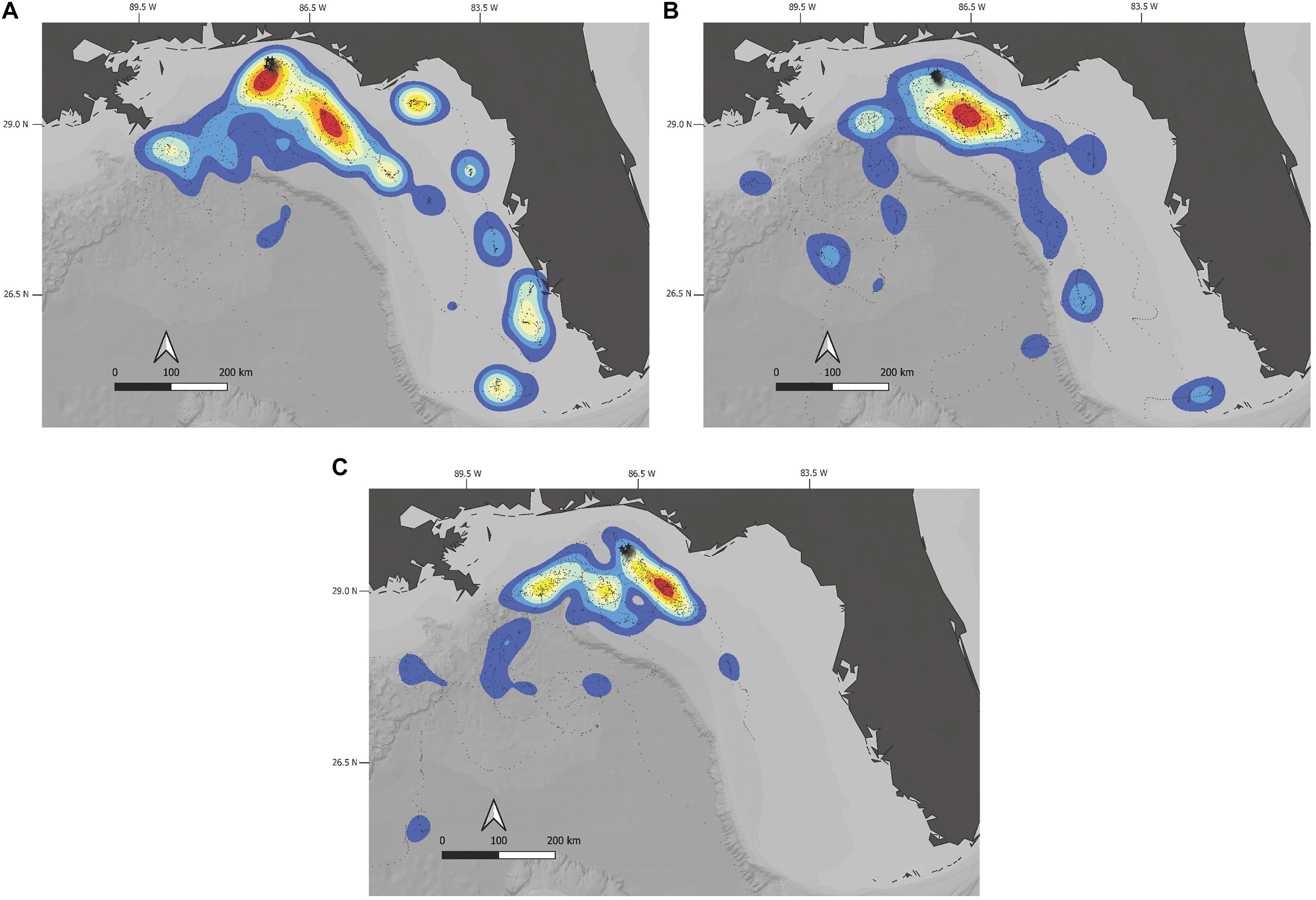
Figure 2. Kernel density maps by year. Colors represent 12.5% increments of the proportion of total density; warmer colors (reds) are greater density and cooler colors (blues) are lower density. The lowest 12.5% of densities are not shown. Initial capture locations are shown with a star, all other estimated locations are shown by black dots. Kernel density radius was 56.419 km. (A) 2015 Kernel Density Map. (B) 2018 Kernel Density Map. (C) 2019 Kernel Density Map.
We delineated transit from foraging behavior with a state space model (Jonsen, 2016) and inspection of the statistically corrected positions. We observed three large scale patterns, a general foraging behavior delineated by behavior parameter b > 1.7, transit shown by movement parameter b < 1.4, and a series of estimates that switch rapidly between foraging and searching behavior 1.4 < b < 1.7 (Figure 3).
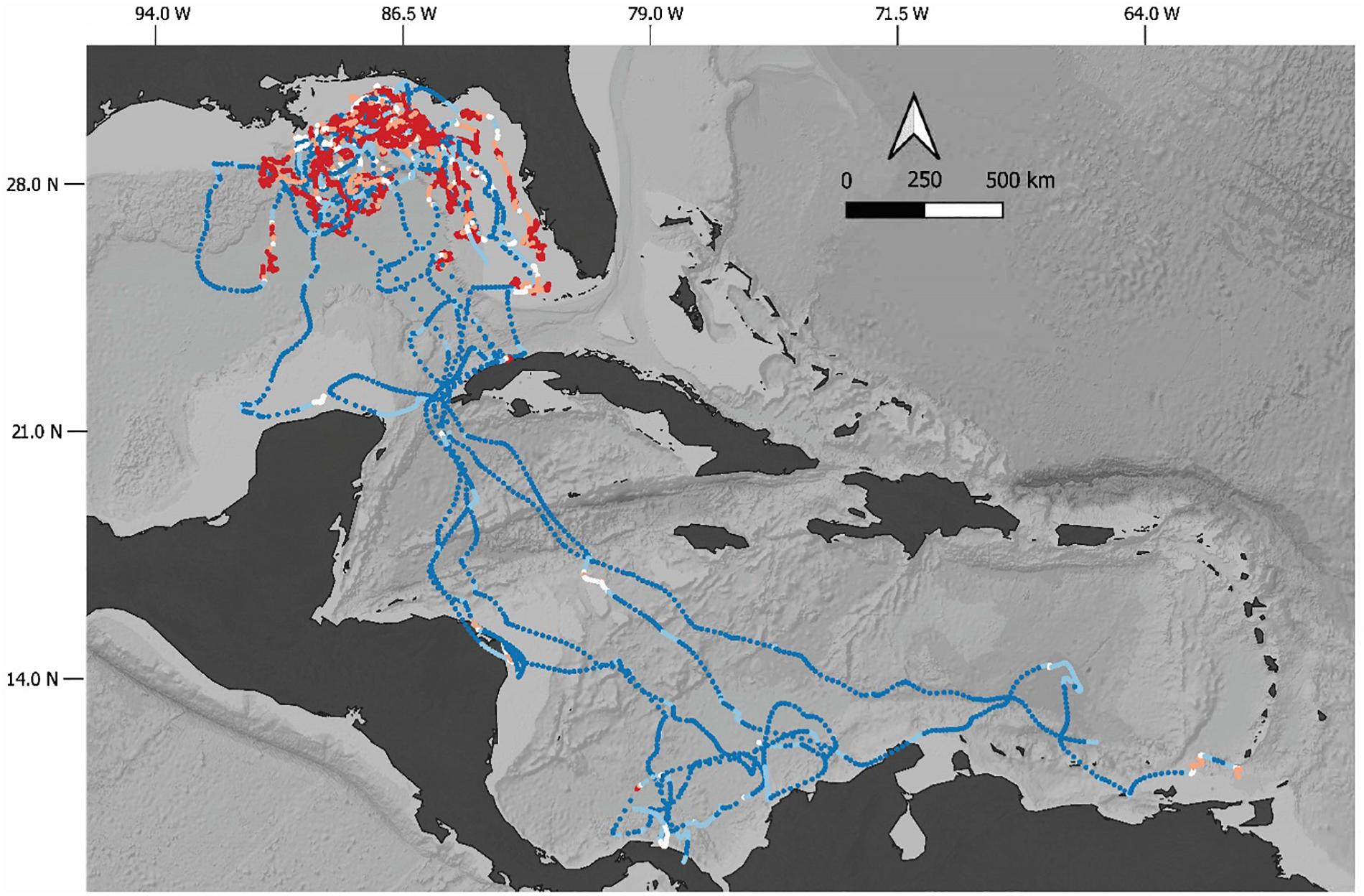
Figure 3. Tracks and behavior states of leatherbacks along satellite tracks. Red represents foraging, blue represents migration, and orange/white/light blue represents searching/foraging.
Kernel Density maps are presented by year (Figures 2A–C) to demonstrate intensity of area use by leatherbacks in the eastern Gulf of Mexico for turtles tagged in this research. Use was generally similar among years with use of the west Florida shelf along with a few turtles foraging in the central Gulf of Mexico.
Discussion
Our results build upon previous studies and fisheries bycatch records to demonstrate consistent use of the northeastern Gulf of Mexico as a foraging area for leatherback turtles (Garrison and Stokes, 2017; Aleksa et al., 2018b). Moreover, capture of turtles previously tagged on nesting beaches, as well as tracking turtles returning to nesting beaches, demonstrate the importance of the region for leatherbacks from numerous nesting areas. The northeastern Gulf of Mexico is likely advantageous due to its proximity to nesting assemblages in the Caribbean and availability of abundant prey. The leatherbacks we tracked leatherbacks spent nearly all their time foraging while on the continental shelf of the Florida Panhandle (Figure 3). Migration off the presumed foraging area began in late October and continued through early December, but it is not clear whether changes in water temperature, photoperiod, or prey abundance triggered movements from the presumed foraging area. Most of the leatherbacks moved south into waters of the west Florida continental shelf with the prevailing current direction. A smaller number moved across the deeper water of the central Gulf of Mexico during their southern migration, swimming against the Loop Current. The turtles migrating along the shelf likely foraged as they moved and engaged in intermediate behavior, perhaps due to the patchy availability of prey. In contrast, the turtles that migrated across the central Gulf tended to engage in direct movements south until reaching the continental shelf in the southern Gulf of Mexico. The female turtles that entered the Caribbean migrated for a period, switched to the intermediate searching/foraging behavior, and then returned to transit behavior in a repeating cycle on their way to nesting beaches.
Neither of the male leatherbacks left the Gulf of Mexico, and male turtle 140161 was not tracked long enough to leave the northeastern Gulf foraging area. This turtle grouped genetically with the Florida nesting assemblage (Peter Dutton pers. comm.) which is of note as no females have been tracked from Florida into the Gulf, nor was this assemblage represented in leatherbacks captured in the pelagic longline fishery in the Gulf (Stewart et al., 2016). Male turtle 140166 (Figure 4) left the foraging area in the northeast Gulf, and remained on the west Florida shelf until the tag stopped transmitting in early January 2016, 108 days after deployment. The turtle was genetically linked to the Caribbean (Peter Dutton pers. comm.) but did not appear to be migrating back to the Caribbean for mating, suggesting that males do not necessarily return from the Gulf every year for mating near nesting beaches.
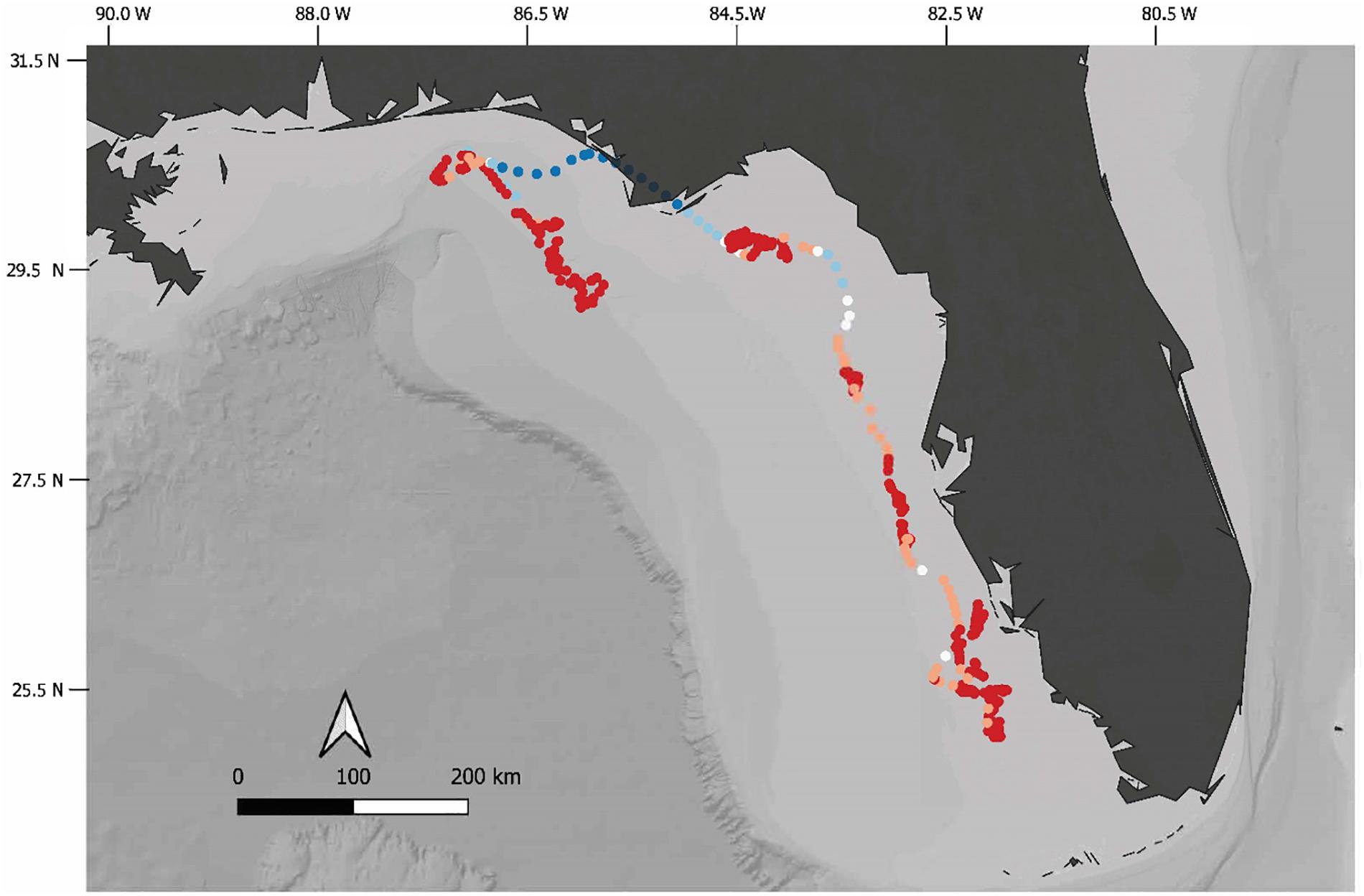
Figure 4. Track and behavior of turtle 140166. Red represents foraging, blue represents migration, and orange/white/light blue represents searching/foraging.
The possible secondary foraging area off southwest Florida identified in Aleksa et al. (2018b) was based on data from a limited number of turtles from our 2015 deployments. One of those turtles was the male 140166, which used the area extensively after migrating south from the foraging area off the Florida Panhandle. With the larger sample size presented here, the entire west Florida shelf is a heavily used foraging area as turtles migrate south in the autumn and winter. Fine scale distribution and abundance of foraging turtles in high use areas along the shelf is likely variable based on prey availability in a given year; however, it is clear that this foraging area provides a source of jellyfish as turtles make their migration back to the Caribbean and/or the northern Gulf of Mexico foraging area.
For those turtles that migrated south in the Gulf and returned to the Caribbean, all followed a similar pattern and entered the Caribbean using the eastern half of the Yucatan Channel (Figure 1). In contrast, when migrating from the Caribbean into the Gulf, turtles used the western half of the Yucatan Channel (see Aleksa et al., 2018b, Figure 1a). This pattern is likely due to prevailing currents in the channel which flow northward in the west and southward in the east. The passage between Cuba and the Yucatan is a corridor between nesting beaches in Central and South America and the Gulf of Mexico, and should be considered for protected area status due to its importance to leatherback migration.
Our results indicate the high use of the eastern Gulf of Mexico compared to the prediction of relative abundance of leatherbacks in Gulf of Mexico presented in Grüss et al.(2018, see Figure 7). Their results are based on reported bycatch of leatherbacks in the pelagic longline fishery rather than telemetry data as presented here. We found extensive use of the west Florida shelf that was not predicted by Grüss et al. (2018), but this is likely because pelagic longline effort data were used to generate their predictions, and effort is extremely low in this region. Bycatch of leatherbacks in the pelagic longline fishery in the Gulf of Mexico is highest in the spring and summer (Quarters 2 and 3) with 11 of 14 observed captures of presumed adult turtles in 2015 occurring in these seasons (Garrison and Stokes, 2017, Table 4). Most of our telemetry data are from autumn. The majority of turtles tracked here did not use the high abundance central Gulf of Mexico area identified in Grüss et al. (2018), but the higher bycatch in spring and summer in the Gulf of Mexico suggests that the central Gulf of Mexico area is an important migratory route for leatherbacks returning to the Gulf from the Caribbean. Aleksa et al. (2018b) showed tracks of returning females that used the central Gulf as such a route on their way to the foraging areas off the Florida Panhandle or the Bay of Campeche. Furthermore, our research demonstrates use of the central Gulf in the autumn for foraging as well as when migrating back to the Caribbean (Figures 1, 3). The central Gulf areas used by some of the leatherbacks in our research overlaps with areas of high pelagic longline fishery effort and observed bycatch (see Figure 3 in Garrison and Stokes, 2017). These areas are also consistent with those predicted to have high abundance by Grüss et al., 2018. Bycatch of leatherbacks in the pelagic longline fishery and post-release mortality are a concern and needs further research to provide quantitative estimates of impacts on annual survival. Future research should also track turtles in other seasons as bycatch records clearly indicate that leatherbacks are present in the Gulf year-round as well as assess the importance of the central Gulf as a migratory pathway to and from the Caribbean.
These results build on the previous research on leatherbacks in the Gulf of Mexico. We have identified several areas that are used by leatherbacks in the Gulf, especially in the late summer through the early winter. Leatherbacks occur in the Gulf year-round so continued research is needed to understand their distribution and behavior throughout the entire year as well as the effects of fisheries bycatch and other anthropogenic threats. The northeastern Gulf is a highly used foraging area in the summer and autumn as is the west Florida shelf and central Gulf as leatherbacks move south in the autumn and winter. In addition, the distinct pattern of entry and exit from the Gulf into the Caribbean makes the Yucatan Channel a seasonally important area for all Caribbean nesting leatherback assemblages.
Data Availability Statement
The datasets presented in this article are not readily available because these data are part of an ongoing study. All data will be uploaded to a public repository once the study is complete. Requests to access the datasets should be directed to CS,Y2hyaXMuc2Fzc29Abm9hYS5nb3Y=.
Ethics Statement
National Marine Fisheries Service’s Atlantic Institutional Animal Care and Use Committee (IACUC) reviewed and approved all procedures and methods. The animal study was reviewed and approved by NOAA Fisheries.
Author Contributions
CS contributed to conception, field operations, analysis, and writing. SB contributed to conception, field operations, and writing. PR and NP contributed to analysis and writing. MJ, BS, and DS contributed to field operations and writing. All authors contributed to the article and approved the submitted version.
Funding
Funding for this research was providing by the National Marine Fisheries Service Protected Species Stock Assessment Improvement Plan and the Southeast Fisheries Science Center.
Conflict of Interest
NP was employed by the company LGL Ecological Research Associates.
The remaining authors declare that the research was conducted in the absence of any commercial or financial relationships that could be construed as a potential conflict of interest.
Acknowledgments
We wish to thank Jesse Wicker, Errol Ronje, and Joe Bishop for captaining our capture vessels. Katrina Aleksa provided great insight into jellyfish in the Gulf of Mexico. NOAA OMAO and Anthem Aircraft provided aircraft support. Heidi Malizia, Stephanie Durkacz, and Paul Nagelkirk spotted turtles for us from the NOAA Twin Otter. We were successful in our capture operations due to the assistance of Josh Summers, Kyle Dettloff, and, especially, Karin Forney. Noah Richards assisted us in the creation of our figures in QGIS. This research would not have been possible without vessel and staff support from the Southeast Fisheries Science Center Mammal Program.
References
Aleksa, K. T., Chiaverano, L., Sasso, C. R., Benson, S., Forney, K., Stacy, B., et al. (2016). “Drymonema in the Gulf of Mexico and foraging by leatherback turtles,” in Proceedings of the 5th International Jellyfish Bloom Symposium, (Vancouver, BC: University of British Columbia).
Aleksa, K. T., Nero, R. W., Wiggert, J. D., and Graham, W. M. (2018a). Descriptive density models of scyphozoan jellyfsh in the northern Gulf of Mexico. Mar. Ecol. Prog. Ser. 591, 71–85. doi: 10.3354/meps12327
Aleksa, K. T., Sasso, C. R., Evans, D., and Nero, W. (2018b). State space models of leatherbacks in the Gulf of Mexico. Mar. Biol. 165:158.
Avens, L., Goshe, L. R., Zug, G. R., Balazs, G. H., Benson, S. R., and Harris, H. (2020). Regional comparison of leatherback sea turtle maturation attributes and reproductive longevity. Mar. Biol. 167:4.
Benson, S. R., Eguchi, T., Foley, D. G., Forney, K. A., Bailey, H., Hitipeuw, C., et al. (2011). Large-scale movements and high-use areas of western Pacific leatherback turtles. Dermochelys coriacea. Ecosphere 2:art84. doi: 10.1890/ES11-00053.1
Benson, S. R., Forney, K. A., Harvey, J. T., Carretta, J. V., and Dutton, P. H. (2007). Abundance, distribution, and habitat of leatherback turtles (Dermochelys coriacea) off California, 1990-2003. Fishery Bull. 105, 337–347.
Blumenthal, J. M., Solomon, J. L., Bell, C. D., Austin, T. J., Ebanks-Petrie, G., Coyne, M. S., et al. (2006). Satellite tracking highlights the need for international cooperation in marine turtle management. Endangered Species Res. 2, 51–61. doi: 10.3354/esr002051
David, L. T., and Kjerfve, B. (1998). Tides and currents in a two-inlet coastal lagoon: laguna de terminos. Mexico. Cont. Shelf. Res. 18, 1057–1079. doi: 10.1016/s0278-4343(98)00033-8
Dodge, K. L., Galuardi, B., Miller, T. J., and Lutcavage, M. E. (2014). Leatherback turtle movements, dive behavior, and habitat characteristics in ecoregions of the northwest Atlantic Ocean. PLoS One 9:e91726. doi: 10.1371/journal.pone.0091726
Eckert, S. (2006). High-use oceanic areas for Atlantic leatherback sea turtles (Dermochelys coriacea) as identified using satellite telemetered location and dive information. Mar. Biol. 149, 1257–1267. doi: 10.1007/s00227-006-0262-z
Eckert, S., Bagley, D., Hargrove, S., Ehrhart, L., Johnson, C., Stewart, K., et al. (2006). Internesting and postnesting movements and foraging habitats of leatherback sea turtles (Dermochelys coriacea) nesting in Florida. Chelonian Conserv. Biol. Chelonian Conserv. Biol. 5, 239–248. doi: 10.2744/1071-8443(2006)5[239:iapmaf]2.0.co;2
Fossette, S., Ferraroli, S., Tanaka, T., Ropert-Coudert, Y., Arai, N., Sato, K., et al. (2007). Dispersal and dive patterns in gravid leatherback turtles during the nesting season in French Guiana. Mar. Ecol. Prog. Ser. 338, 233–247. doi: 10.3354/meps338233
Garrison, L. P., and Stokes, L. (2017). Estimated Bycatch of Marine Mammals and Sea Turtles in the U.S. Atlantic Pelagic Longline Fleet During 2015. NOAA Technical Memorandum NMFS-SEFSC - Report No. 709. Washington, D.C: NOAA.
Gaspar, P., Georges, J. Y., Fossette, S., Lenoble, A., Ferraroli, S., and Le Maho, Y. (2006). Marine animal behaviour: neglecting ocean currents can lead us up the wrong track. Proc. R. Soc. B: Biol. Sci. 273, 2697–2702. doi: 10.1098/rspb.2006.3623
Grüss, A., Drexler, M. D., Ainsworth, C. H., Roberts, J. J., Carmichael, R. H., Putman, N. F., et al. (2018). Improving the spatial allocation of marine mammal and sea turtle biomasses in spatially explicit ecosystem models. Mar. Ecol. Prog. Ser. 602, 255–274. doi: 10.3354/meps12640
Hays, G., Houghton, J., and Myers, A. (2004). Endangered species: Pan-Atlantic leatherback turtle movements. Nature 429:522. doi: 10.1038/429522a
Hays, G. C., Bailey, H., Bograd, S. J., Bowen, W. D., Campagna, C., Carmichael, R. H., et al. (2019). Translating marine animal tracking data into conservation policy and management. Trends Ecol. Evol. 34, 459–473.
Heaslip, S. G., Iverson, S. J., Bowen, W. D., and James, M. C. (2012). Jellyfsh support high energy intake of leatherback sea turtles (Dermochelys coriacea): video evidence from animal-borne cameras. PLoS One 7:e33259. doi: 10.1371/journal.pone.0033259
James, M. C., Myers, R. A., and Ottensmeyer, C. A. (2005). Behaviour of leatherback sea turtles, dermochelys coriacea, during the migratory cycle. Proc. R. Soc. B: Biol. Sci. 272, 1547–1555. doi: 10.1098/rspb.2005.3110
James, M. C., Sherrill-Mix, S. A., and Myers, R. A. (2007). Population characteristics and seasonal migrations of leatherback sea turtles at high latitudes. Mar. Ecol. Prog. Ser. 337, 245–254. doi: 10.3354/meps337245
Jonsen, I. D. (2016). Joint estimation over multiple individuals improves behavioural state inference from animal movement data. Sci. Rep. 6:20625.
Jonsen, I. D., Myers, R. A., and James, M. C. (2007). Identifying leatherback turtle foraging behaviour from satellite telemetry using a switching state-space model. Mar. Ecol. Prog. Ser. 337, 255–264. doi: 10.3354/meps337255
Mills Flemming, J., Jonsen, I. D., Myers, R. A., and Field, C. A. (2010). Hierarchical state-space estimation of leatherback turtle navigation ability. PLoS One 5:e14245. doi: 10.1371/journal.pone.0014245
National Marine Fisheries Service, and U.S. Fish and Wildlife Service. (2020). Endangered Species Act status review of the leatherback turtle (Dermochelys coriacea). Washington, D.C: National Marine Fisheries Service Office of Protected Resources and U.S. Fish and Wildlife Service.
NMFS SEFSC – National Marine Fisheries Service Southeast Fisheries Science Center. (2008). Sea turtle research techniques manual. NOAA Technical Memorandum NMFS-SEFSC - Report. 579. Washington, D.C: NOAA.
Oppel, S., Bolton, M., Carneiro, A. P., Dias, M. P., Green, J. A., Masello, J. F., et al. (2018). Spatial scales of marine conservation management for breeding seabirds. Mar. Pol. 98, 37–46.
R Development Core Team. (2019). R: A Language and Environment for Statistical Computing. Vienna: R Foundation for Statistical Computing.
Keywords: movement ecology, migration, foraging, leatherback turtle, Gulf of Mexico
Citation: Sasso CR, Richards PM, Benson SR, Judge M, Putman NF, Snodgrass D and Stacy BA (2021) Leatherback Turtles in the Eastern Gulf of Mexico: Foraging and Migration Behavior During the Autumn and Winter. Front. Mar. Sci. 8:660798. doi: 10.3389/fmars.2021.660798
Received: 29 January 2021; Accepted: 01 April 2021;
Published: 28 April 2021.
Edited by:
Donna Jill Shaver, National Park Service, United StatesReviewed by:
Roldan A. Valverde, Southeastern Louisiana University, United StatesRichard Reina, Monash University, Australia
Copyright © 2021 Sasso, Richards, Benson, Judge, Putman, Snodgrass and Stacy. This is an open-access article distributed under the terms of the Creative Commons Attribution License (CC BY). The use, distribution or reproduction in other forums is permitted, provided the original author(s) and the copyright owner(s) are credited and that the original publication in this journal is cited, in accordance with accepted academic practice. No use, distribution or reproduction is permitted which does not comply with these terms.
*Correspondence: Christopher R. Sasso, Y2hyaXMuc2Fzc29Abm9hYS5nb3Y=
 Christopher R. Sasso
Christopher R. Sasso Paul M. Richards
Paul M. Richards Scott R. Benson
Scott R. Benson Michael Judge
Michael Judge Nathan F. Putman
Nathan F. Putman Derke Snodgrass
Derke Snodgrass Brian A. Stacy
Brian A. Stacy